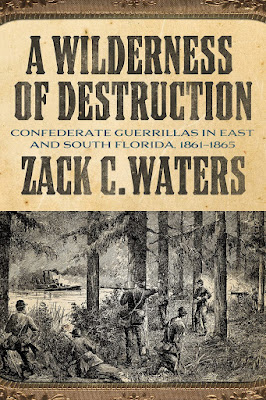Here is another review of my brother Zack's great Civil War book, A Wilderness of Destruction, about Florida's role in attempting to save the homeland during that devastating conflict. Zack has several possible awards coming up, and I hope he is honored for the massive amount of research he did and the fine writing that he is known for.
Perspectives on the Civil War Era from the Journal, Civil War Book Review
A Wilderness of Destruction: Confederate Guerrillas of East and South Florida, 1861–1865
Author: Zack C. Waters
Book Review by Ralph Mann
University of Colorado
Zack Waters, a veteran researcher and writer on Florida’s Civil War, has written a very comprehensive survey of guerrilla warfare in east and south Florida. It is based on a huge amount of reading and research in the available secondary literature, as well as in the records of Florida’s Civil War government and federal records of the War of the Rebellion (OR) and Official Records of the Union and Confederate Navies in the War of the Rebellion (ORN). He looks at engagements at all levels, from ambushes to pitched, although small-scale, battles. He recounts Union officers being captured while partying and wagon trains seized on the way to Union-held towns and fortifications, as well as battles for towns—Gainesville, Jacksonville. It is hard to imagine a fight he has missed, including a bloodless skirmish on a creek I crossed every day going to junior high and high school. As long as the conflict can be classified as a guerrilla action, or involves men he identifies as guerrillas, he recounts it.
This coverage is vital for understanding Florida’s Civil War, because all the Confederate government wanted from Florida [were] soldiers and cattle, and it essentially abandoned the state early in the war. Florida’s Confederate soldiers would fight in the Armies of Northern Virginia and Tennessee, leaving the defense of the state to its own resources—which, as Florida’s governor, John Milton, quickly realized, meant a regiment under state control. His efforts resulted by mid-1862 in the 2nd Florida Cavalry, raised by locally influential men, generally large planters, and soon operating as guerrillas. One of the companies, from Marion County (Ocala), was led by John J. Dickison, who would be the state’s most effective partisan raider, and whose memoir would become Waters’ prime source for combat descriptions.
Waters is very aware of the dangers of research into a topic as controversial, then and now, as guerrilla warfare. His sources are inherently biased—often for self-glorification or self-defense. Postwar memoirs could easily be caught up in “Lost Cause” rhetoric of gallant knights and loyal squires. Northern newspapers were just as prone to puffery as Southern, and even Dickison, Waters notes, was never modest.
Waters deals with this by juxtaposing accounts by both sides, to an effect that sometimes makes it hard to believe they are depicting the same engagement. Civilians caught up in the fighting suffered disproportionately and bitterly resented guerrilla leaders who enforced conscription or impressed supplies. Especially late in the war, the fighting devolved into robbery, revenge murder, arson, and family rivalry for local power, completely divorced from military goals. Race, of course, was central to the war, and Waters does not shy away from the bigotry that hamstrung cooperation between white unionist Floridians and the African Americans in the United States Army. It is clear that some guerrillas imprisoned white captives but lynched black ones as runaways or “deserters.” (Waters applauds Dickison for, unlike other guerrillas, not killing captives white or black.) And, in the end, there were totally meaningless murders.
The book is organized chronologically and by region, and that results in some repetition. And while Florida was isolated from the rest of the Confederacy, some national policies relevant to the Florida conflict should be noted. Particularly relevant is the Confederate Partisan Ranger Act of 1862, which attempted to regulate partisan warfare—and its subsequent revocation because partisan warfare, independent and close to home, was too attractive and drew men from the regular army. Did the act have any impact on Florida? The Lieber Code of 1863, which defined how Union troops were supposed to distinguish between legitimate partisans and outlaws, might also have been worth discussion, as some Florida battles combined units of the 2nd Florida, temporary outfits led by local politicians, and random rebel enthusiasts with rifles.
Was the Lieber Code ever applied in Florida? But it is never fair to ask an author to write about issues outside of his primary goal in a book, and taken as it is, it is hard to imagine that anyone else will try to duplicate Waters’s exhaustive coverage of Florida’s war.
Ralph Mann, who is Emeritus in history at the University of Colorado, Boulder, graduated from Nathan Bedford Forrest High, in Jacksonville, Florida.



No comments:
Post a Comment